1 Introduction
In the 21st century, mankind will face major challenges to achieve sustainable economic and social development. Under the dual constraints of limited resources and environmental protection, the energy problem will become more prominent, which is mainly reflected in: â‘ energy shortage; â‘¡ environmental pollution; â‘¢ greenhouse effect. Therefore, when solving the energy problem and achieving sustainable development, mankind can only rely on scientific and technological progress to develop and utilize renewable clean energy on a large scale. Solar energy has the advantages of large reserves, widespread existence, economical use, clean and environmental protection, etc. Therefore, the use of solar energy has received more and more attention from people and has become an ideal alternative energy source. The power described in the article is a 200W solar photovoltaic grid-connected inverter, which directly converts the direct current generated by the solar panel into a 220V / 50Hz power frequency sinusoidal AC output to the power grid.
2 System working principle and control scheme
2.1 The principle of photovoltaic grid-connected inverter circuit
The main circuit schematic diagram of the solar photovoltaic grid-connected inverter is shown in Figure 1. In this system, the rated voltage of the solar panel output is 62V DC, which is converted into 400V DC by a DC / DC converter, and then 220V / 50Hz AC is obtained after DC / AC inverter. The system ensures that the 220V / 50Hz sinusoidal current output by the grid-connected inverter is synchronized with the phase voltage of the power grid.

Figure 1 Block diagram of the circuit
2.2 System control scheme
Figure 2 is the main circuit topology diagram of the photovoltaic grid-connected inverter. This system is composed of the DC / DC converter at the front stage and the DC / AC inverter at the rear stage. The inverter circuit of DC / DC converter can be selected from half-bridge type, full-bridge type, and push-pull type. Considering the low input voltage, if the half-bridge type is used, the current of the switch tube becomes larger, while the full-bridge type is used for complicated control and the power consumption of the switch tube is increased. Therefore, a push-pull circuit is used here. The DC / DC converter consists of a push-pull inverter circuit, a high-frequency transformer, a rectifier circuit, and a filter inductor. It converts the 62V DC voltage output by the solar panel into a 400V DC voltage.
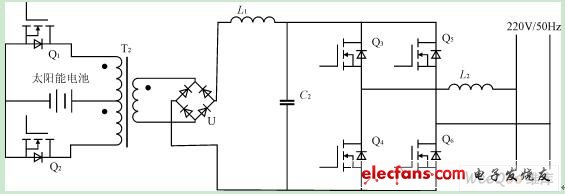
Fig. 2 Main circuit topology
The main circuit of the DC / AC inverter adopts a full-bridge structure and is composed of 4 MOS tubes (in which parasitic anti-parallel diodes are parasitic), which converts 400V direct current into 220V / 50Hz power frequency alternating current.
2.2.1 DC / DC converter control scheme
The control block diagram of the DC / DC converter is shown in Figure 3. The control circuit is based on the integrated circuit SG3525, and the two 50kHz drive signals output by the SG3525 are added to the gates of the push-pull circuit switch tubes Q1 and Q2 via the gate drive circuit. In order to keep the output voltage of the DC / DC converter stable, the detected output voltage is compared with the command voltage. This error voltage controls the duty cycle of the SG3525 output drive signal after the PI regulator. The control circuit also has a protection function to limit the output overcurrent and overvoltage. When it is detected that the output current of the DC / DC converter is too large, the SG3525 will reduce the width of the gate pulse, reduce the output voltage, and then reduce the output current. When the output voltage is too high, the operation of the DC / DC converter will be stopped. Since the push-pull circuit is prone to saturation of the transformer due to DC bias, the design difficulty of the push-pull circuit is how to prevent the magnetic saturation of the transformer. In this circuit, in addition to paying attention to the symmetry of the circuit, a magnetic saturation detection circuit is designed. When the current flowing through the two branches of the push-pull circuit is unbalanced, the soft start function of the SG3525 will be activated to make the DC / DC The converter restarts and the transformer is reset.
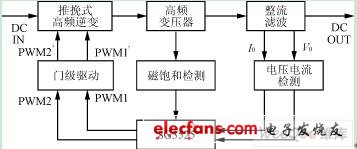
Figure 3 DC / DC converter control block diagram
The bias detection circuit is shown in Figure 4. Only the secondary side of the magnetic ring is drawn in the figure. The two coils on the primary side are connected to the two windings on the primary side of the transformer of the main circuit, and the directions of the current flowing through the two coils are opposite. When the transformer is biased, the current in one direction is abnormally large, and a current transformer can detect a voltage on the output resistance R1 of the transformer. If the voltage is large enough, the voltage stabilizing diode D5 can be turned on. A voltage drop occurs on the potentiometer, adjust the value of the potentiometer to an appropriate resistance value, make the voltage drop on the potentiometer greater than the threshold voltage of the triode, make the triode conductive, and connect the capacitor between the pin 8 of the chip SG3525 and ground Discharge, then the constant current source in SG3525 charges it, SG3525 restarts, thus resetting the transformer core.
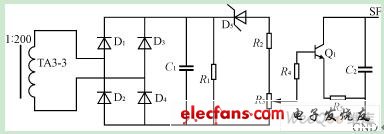
Figure 4 Bias detection circuit
2.2.2 DC / AC inverter control scheme
DC / AC inverter is the focus and difficulty of photovoltaic grid connection, so the following part will focus on this part. The control block diagram of DC / AC inverter is shown in Figure 5. The core control chip uses TI's TMS320F240. Although the single chip microcomputer can also realize the pulse width modulation of the grid-connected inverter, the real-time processing capability of the DSP is more powerful, so it can ensure that the system has a higher switching frequency. It can be clearly seen from Figure 5 that the system input and output signals.

Figure 5 DC / AC inverter control block diagram
2.3 Output power optimization control scheme
Under static conditions, when the grid-connected inverter is connected to the solar cell, the grid-connected inverter can be equivalent to the load resistance of the solar cell. When the light intensity λ and temperature T change, the terminal voltage output by the solar cell will change accordingly. In order to effectively use solar energy, the output of solar cells should always be at an appropriate operating point. Therefore, the control scheme requires that when the voltage of the solar cell increases, its output power can be increased; otherwise, its output power is reduced.
The control scheme of DSP is shown in Figure 6. After comparing the reference voltage with the actual voltage of the solar cell, the error is adjusted by PI, and the obtained current command (DC) IREF is multiplied by the sine table value in the ROM to obtain After alternating the output current command iref, and then comparing it with the actual output current value, its error goes through the proportional (P) link, the obtained command is reversed, and it is added to the collected AC side voltage Us. The obtained waveform is compared with the triangular wave again, and 4 PWM modulation signals are generated (the frequency of the triangular wave is 20 kHz).
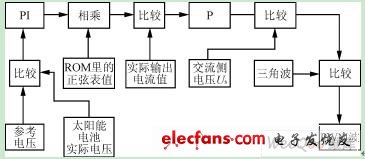
Figure 6 DSP control scheme
2.4 Detection of AC voltage Us
Filtering and rectifying the synchronous signal on the secondary side of the synchronous transformer, you can get a relatively stable DC power and send it to the A / D conversion port of the DSP. Since the resulting DC voltage has a relatively stable relationship with the grid voltage, it is easier to convert the value of Us.
Due to the problem of common ground, the full-wave precision rectifier circuit of the operational amplifier is used, as shown in FIG. 7.

Figure 7 Us rectifier circuit
2.5 Synchronization of current commands
When connecting to the grid, the sine wave current output by the inverter must be at the same frequency and phase as the grid voltage. First, the grid voltage signal is filtered and shaped into a synchronous square wave signal, and then it is input to the external interrupt port XINT1 of the TMS320F240 in order to capture the zero-crossing signal of the grid voltage. As shown in Figure 8, the sine wave of the grid voltage is squared after being shaped.
When the DSP detects the rising edge of the zero-crossing signal, it triggers a synchronous interrupt. The time point is used as the reference to give the starting point of the sine wave signal time, that is, the sine table pointer is reset to zero; whenever T1 underflow interrupt (PWM real-time Control), the sine table pointer will increase by 1, and take the value from the sine table. One cycle of unit sine wave data is divided into 400 points and stored in memory in the form of a table. Since the synchronization signal is more susceptible to interference from harmonics and spike voltage, you can make a delay after entering the synchronization interrupt to determine whether the external interrupt pin XINT1 is still high. If it is high, execute the interrupt program. Otherwise, jump out of the interrupt program.
It can be seen from the control scheme in Fig. 6 that after multiplying IREF with the data in the sine table, a current given signal of sine wave with adjustable amplitude is formed. Then, the current given value is compared in real time, after the P link After the obtained signal is inverted, it is added to the collected AC-side grid voltage signal Us, and the resulting waveform is compared with the triangle wave to generate a PWM wave to control the switching of the bridge arm. In short, the requirements of the same frequency and same phase of output current and grid voltage are realized by current tracking control.
2.6 Generation of PWM pulse width modulated wave
The generation of PWM wave is output through the full comparison unit of TMS320F240, the frequency is 20kHz. It can be seen from Fig. 6 that the modulation pulse is generated by comparing the current command value with the actual current value, and after P link, the obtained waveform is obtained by comparing with the triangular wave (frequency is 20kHz). Therefore, the MOS tube Q3, Q4, Q5, Q6 (see Figure 2) pulse generation time can be derived from Figure 8, with reference to sine wave and triangle wave modulation, the intersection of the two determines the PWM pulse time. The actually sampled waveform (actually a staircase wave) intersects the triangle wave, and the pulse width is obtained from the intersection point. This system is a staircase wave formed by sampling the waveform at the bottom point of the triangle wave. The position of the pulse width determined by the intersection of the step wave and the triangle wave within a sampling period is symmetrical, as shown in FIG. 9.

Figure 8 Synchronization signal waveform
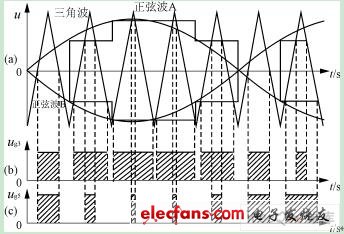
Figure 9 Sinusoidal pulse width modulation waveform
Figure 9 (a) The intersection of sine wave B and triangle wave determines the conduction time of Q3; the intersection of sine wave A and triangle wave determines the conduction time of Q5.
Figure 9 (b) is a schematic diagram of the pulse of Q3. The pulses of Q3 and Q4 on the same bridge arm are complementary.
Figure 9 (c) is a schematic diagram of the pulse of Q5. The pulses of Q5 and Q6 on the same bridge arm are complementary.
2.7 TMS320F240 software control process
This part of the software is mainly divided into 4 blocks, namely the main program, T1 underflow interrupt, T2 underflow interrupt and synchronous interrupt. The flow chart is shown in Figure 10. T1 underflow interrupt occurs every 50μs, the program is mainly used to generate PWM waves; T2 underflow interrupt occurs every 10ms, the program is mainly used to generate current commands; synchronous interrupt occurs about once every 20ms (network voltage cycle).

Figure 10 Software flow chart
2.8 System protection
The system is designed with multiple protections such as overvoltage, undervoltage on the DC side, overcurrent on the AC side, and overheating. When the output voltage of the solar panel is overvoltage or undervoltage, the TMS320F240 sends a signal to the SG3525 to block the DC / DC pulse and stop it. When the DC voltage is detected to return to normal, the DC / DC again Automatic reset starts to work; when AC overcurrent or overheating fault occurs, the program enters the interrupt service subroutine to block all driving signals. When the fault is removed, manually reset and the system restarts.
3 Selection of main components and experimental waveforms
The MOSFET used for the push-pull circuit is IRFP350 (withstand voltage 400V, rated drain current 16A). The bridge inverter circuit MOS tube uses IRFPC40 (withstand voltage 600V, drain source rated current 6.8A). DC / DC filter inductance L1 selects 1.2mH, DC / AC filter inductance L2 selects 33.4mH.
Fig. 11 is the waveform of voltage and current when the output side of the inverter is connected to the grid. The voltage on the grid side is 220 ± 20%, and the effective value of the current is about 1A.
4 Conclusion
This article describes a control system for a low-power photovoltaic grid-connected inverter. The topology of the DC / DC controller uses a push-pull circuit, which is controlled by the chip SG3525, which effectively prevents bias; the DC / AC inverter is a full-bridge inverter circuit, which is controlled by DSP Since the calculation speed of DSP is relatively high, the output current of the inverter can track the grid voltage waveform well. The effectiveness of the photovoltaic grid-connected inverter control scheme has been verified in the laboratory. The control system can ensure that the output power factor of the inverter power supply is close to 1, and the output current is sinusoidal.
MC Plus series Outdoor LED Light Box Advertising P6 LED Display
1. Integrated design: Outdoor LED Display's power and receiver card integrated in the control panel, no signal cable between the module and the power line, greatly improving the stability and reliability;
2. Full Color Outdoor LED Light Box has stable circuit control technology, simple operation, easy maintenance;
3. Outdoor Led light box Advertising P6 LED Display use unique die-cast aluminum box structure, stable, durable, lightweight;
4. "light, thin, dense" feature, in order to provide a greater realization of creative space;
5. Led display billboard is accurate, fast and flexible installation location, can effectively respond to different application areas;
6. Outdoor full color led display with deep gray scale processing technology, high-quality screen refresh, High Definition and create fantastic stage effects;
Outdoor LED Light Box
Outdoor LED Light Box,Outdoor LED Advertising Light Box,Outdoor LED Advertising Scrolling Light Box,Outdoor Waterproof LED Light Box
Shenzhen Macion Optoelectronics Technology Co.,Ltd. , https://www.macion-led.com